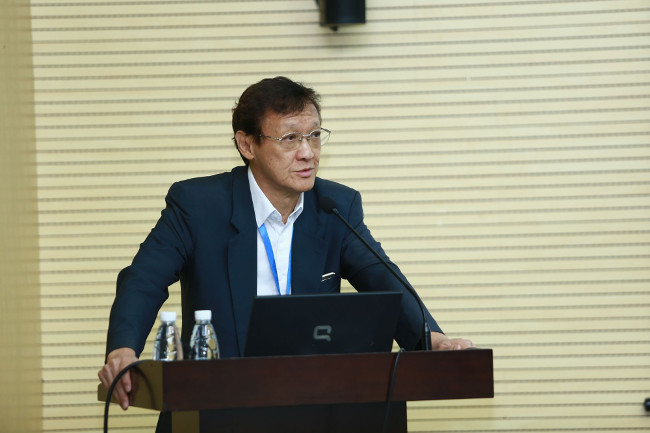
On July 17 and 18, SUSTech and the Guangdong Academy of Sciences co-sponsored the Chinese Academy of Sciences Discipline Development Strategy Project Seminar which was held on the university campus. Experts and specialists from Zhejiang University, the Chinese University of Hong Kong, Nanjing University, China University of Science and Technology, Suzhou University of Science and Technology, Shanghai Jiaotong University, East China University of Science and Technology, Yanshan University, Southeast University and more than 10 other institutions of higher learning and scientific research came together to discuss the latest trends and research on Low Dimension Artificial Microstructure and Its Interface and Surface Science Development. The meeting was chaired by Tang Shuxian, member of the Chinese Academy of Sciences.
The topics discussed during the seminar included the establishment of advanced catalytic materials, low-dimensional electronic materials, special functional materials, biomedical materials, in-depth research on low-dimensional artificial microstructure for clean energy production, heterogeneous catalysis, environmental materials, electronic materials, topological materials and other major cutting edge scientific areas and their applications in the development of the national economy.
In recent years, low-dimensional artificial microstructure has rapidly become a trending topic in international scientific research, and countries have invested heavily in this field due to its relationship with energy and the environment, but also health, intelligent life and other exciting fields and applications. The nature of low-dimensional materials has a very close relationship with its microstructure, and can control its structure to control its electronic structure, and its functional modification, change its surface’s physical and chemical behavior, and obtain the desired properties, so as to create super-performance, multi-functional and intelligent new materials. These can be used in catalysis, energy and environment, flexible electronic devices, biomedical applications and many other fields.

Member of the Chinese Academy of Sciences and Professor of Nanjing University Zou Zhigang pointed out that the field of photocatalytic materials is close to a major breakthrough, the technology is at a critical stage of large-scale application. He said it was very important to study the design theory and preparation science of high efficiency photocatalytic materials, the theory of photocatalytic reaction based on molecular level and the construction and application of high efficiency photocatalytic reaction systems, in order to compete and progress in the international sphere.

Member of the Chinese Academy of Sciences Ye Hengqiang said that the general foundation knowledge of low-dimensional materials is an important signal for the high-tech industry and advanced manufacturing. Currently research in low-dimensional materials has paved the way to a vigorous development period, and will lead to significant economic and industrial innovations.

Member of the Chinese Academy of Sciences and Professor at Nanjing University Dou Youwei gave a final speech in which he said that the fourth industrial revolution will be nano-technology-led, with a key role for nano-magnetic materials, low-dimensional materials, and that an unlimited number of combinations and developments will build a diverse new world of materials.
The seminar is an important part of the “Low Dimensional Artificial Microstructure and Its Interface and Surface Science” disciplines development strategy research project. The seminar aims to provide scientific breakthroughs for technological innovation in the field of low-dimensional materials through in-depth exchanges and academic research. China’s new generation of information technology and environmental protection energy technology has made huge progress recently, and still has a long road to go.
Proofread By
Photo ByDepartment of Physics